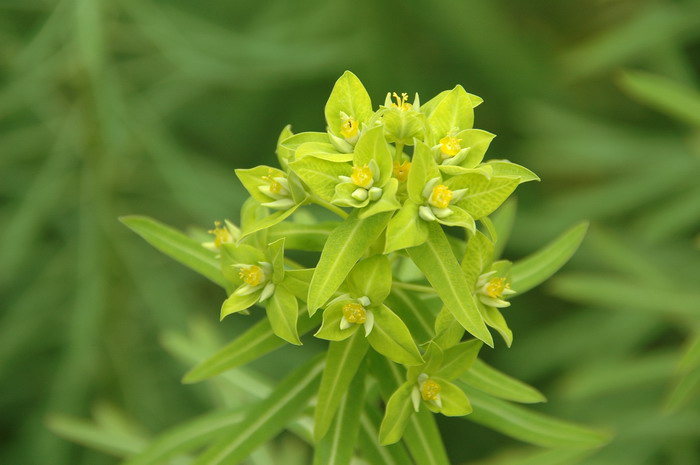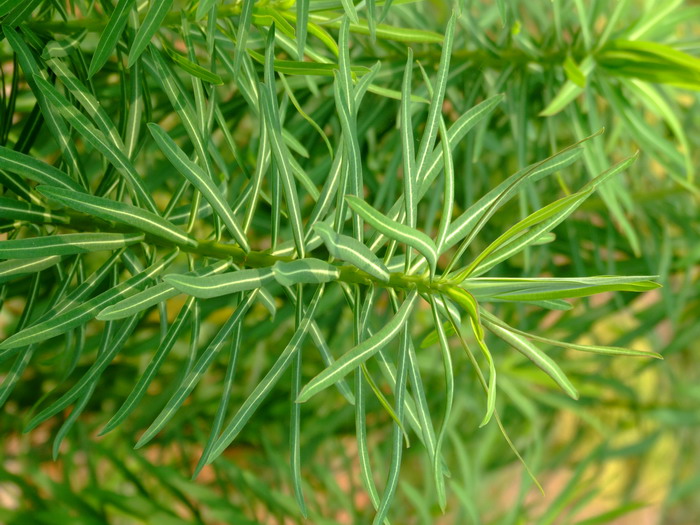乳浆大戟Euphorbia esula
中文名(Chinese Name):乳浆大戟
学名(Scientific Name):Euphorbia esula L.
英文名(English Common Name):leafy spurge
别名(Chinese Common Name):猫眼草、华北大戟
异名(Synonym):Euphorbia glomerulans Prokh. Euphorbia minxianensis W. T. Wang Euphorbia esula var. cyparioides Boiss. Euphorbia tarokoensis Hayata Euphorbia esula var. latifolia Ledeb. Euphorbia kaleniczenkii Czern. ex Trautv. Euphorbia lunulata Bunge Euphorbia mandshurica Maxim. Tithymalus esula (L.) Hill Keraselma esula (L.) Raf. Euphorbion esulum (L.) St.-Lag. Euphorbia esula var. genuina Boiss.
科属(Family & Genus):大戟科(Euphorbiaceae)大戟属
形态特征(Description):多年生草本。根圆柱状,长20厘米以上,直径3-5 (6)毫米,不分枝或分枝,常曲折,褐色或黑褐色。茎单生或丛生,单生时自基部多分枝,高30-60厘米,直径3-5毫米;不育枝常发自基部,较矮,有时发自叶腋。叶线形至卵形,变化极不稳定,长2-7厘米,宽4-7毫米,先端尖或钝尖,基部楔形至平截;无叶柄;不育枝叶常为松针状,长2-3厘米,直径约1毫米;无柄;总苞叶3-5枚,与茎生叶同形;伞幅3-5,长2-4 (5)厘米;苞叶2枚,常为肾形,少为卵形或三角状卵形,长4-12毫米,宽4-10毫米,先端渐尖或近圆,基部近平截。花序单生于二歧分枝的顶端,基部无柄;总苞钟状,高约3毫米,直径2.5-3.0 毫米,边缘5裂,裂片半圆形至三角形,边缘及内侧被毛;腺体4,新月形,两端具角,角长而尖或短而钝,变异幅度较大,褐色。雄花多枚,苞片宽线形,无毛;雌花1枚,子房柄明显伸出总苞之外;子房光滑无毛;花柱3,分离;柱头2裂。蒴果三棱状球形,长与直径均5-6毫米,具3个纵沟;花柱宿存;成熟时分裂为3个分果爿。种子卵球状,长2.5-3.0 毫米,直径2.0-2.5毫米,成熟时黄褐色;种阜盾状,无柄。花果期4-10月。
分布(Distribution):除海南、贵州、云南和西藏外其他各省区均有。生于路旁、杂草丛、山坡、林下、河沟边、荒山、沙丘及草地。广布于欧亚大陆。
用途(Use):种子含油量达30%,工业用;全草入药,具拔毒止痒之效。
引自中国植物志英文版FOC Vol. 11 Page 291, 312, 313
Euphorbia esula Linnaeus, Sp. Pl. 1: 461. 1753.
乳浆大戟 ru jiang da ji | Euphorbiaceae | Euphorbia
Euphorbia croizatii Hurusawa; E. cyparissias Linnaeus; E. distincta Stscheglejew; E. eriophylla Karelin & Kirilov; E. esula var. latifolia Ledebour; E. leoncroizatii Oudejans; E. lunulata Bunge; E. maackii Meinshausen; E. mandshurica Maximowicz; E. minxianensis W. T. Wang; E. nakaiana H. Léveillé; E. octoradiata H. Léveillé & Vaniot; E. subcordata C. A. Meyer ex Ledebour; E. takouensis H. Léveillé & Vaniot; E. tarokoensis Hayata; Tithymalus esula (Linnaeus) Hill; T. lunulatus (Bunge) Soják; T. mandshuricus (Maximowicz) Soják; T. subcordatus Klotzsch & Garcke.
Herbs, erect, (15-)30-60 cm tall. Rootstock enlarged or sometimes extensively rhizomatous, brown or dark brown, up to 20 cm × 3-5(-6) mm, branched or not. Stems single or clustered, many branched basally, 3-5 mm thick; sterile stems sometimes present, sometimes overtopping inflorescence. Leaves alternate, often larger toward stem apex; stipules absent; basal scale-leaves few; petiole absent; leaf blade linear to ovate, very variable, (1.5-)2-7 × (0.15-)0.4-0.7(-1.2) cm, base attenuate, cuneate, or truncate, apex acuminate or acute; leaves on sterile branches denser, needlelike, 2-3 × ca. 0.1 cm. Inflorescence a terminal pseudumbel, often with lateral cymes from axils below; cymes mostly dichotomous; primary involucral leaves 3-8, similar to normal leaves to almost orbicular, primary rays 3-8, 2-4(-5) cm; cyathophylls 2, sometimes overlapping at base, usually reniform, occasionally ovate or triangular-ovate, pair often forming complete circle, 0.4-1.2 × 0.4-1 cm, base subtruncate to shallowly cordate, apex shortly acuminate to rounded. Cyathium sessile; involucre campanulate, ca. 3 × 2.5-3 mm, lobes rounded to triangular, tomentose on margin and inside; glands 4, brown, crescent-shaped, usually 2-horned, horns long and acute to short and obtuse or absent, sometimes so tightly incurved that gland looks circular. Bracteoles linear, glabrous. Male flowers many. Female flower: ovary exserted from cup, smooth, glabrous; styles free, persistent; style arms 2-lobed. Capsule trigonous-globose, 5-6 × 5-6 mm, with 3 vertical furrows. Seeds ovoid-globose, 2.5-3 × 2-2.5 mm, yellow-brown; caruncle present, peltate, sessile. Fl. and fr. Apr-Oct. 2n = 40*.
Roadsides, fields, grasslands, steppes, slopes, sparse forests, sandy areas. Throughout China except Guizhou, Hainan, Xizang, Yunnan [Afghanistan, Japan, Kazakhstan, Korea, Kyrgyzstan, Mongolia, Tajikistan, Turkmenistan, Uzbekistan; SW Asia (Iran), Europe; naturalized in North America].
Euphorbia esula is extremely diverse, especially in the form of the leaf blade, involucral leaves, abortive branches, and the horns of the cyathial glands. However, it can be differentiated from E. kansui and E. sieboldiana by the involucre with 5 lobes and 4 glands (and from E. prolifera) and by the involucre without peduncle (from E. latifolia). There are many synonyms from outside China that are not given here. It is classified as a noxious weed in N America.
The seed oil is used in industry.


(责任编辑:徐晔春)
学名(Scientific Name):Euphorbia esula L.
英文名(English Common Name):leafy spurge
别名(Chinese Common Name):猫眼草、华北大戟
异名(Synonym):Euphorbia glomerulans Prokh. Euphorbia minxianensis W. T. Wang Euphorbia esula var. cyparioides Boiss. Euphorbia tarokoensis Hayata Euphorbia esula var. latifolia Ledeb. Euphorbia kaleniczenkii Czern. ex Trautv. Euphorbia lunulata Bunge Euphorbia mandshurica Maxim. Tithymalus esula (L.) Hill Keraselma esula (L.) Raf. Euphorbion esulum (L.) St.-Lag. Euphorbia esula var. genuina Boiss.
科属(Family & Genus):大戟科(Euphorbiaceae)大戟属
形态特征(Description):多年生草本。根圆柱状,长20厘米以上,直径3-5 (6)毫米,不分枝或分枝,常曲折,褐色或黑褐色。茎单生或丛生,单生时自基部多分枝,高30-60厘米,直径3-5毫米;不育枝常发自基部,较矮,有时发自叶腋。叶线形至卵形,变化极不稳定,长2-7厘米,宽4-7毫米,先端尖或钝尖,基部楔形至平截;无叶柄;不育枝叶常为松针状,长2-3厘米,直径约1毫米;无柄;总苞叶3-5枚,与茎生叶同形;伞幅3-5,长2-4 (5)厘米;苞叶2枚,常为肾形,少为卵形或三角状卵形,长4-12毫米,宽4-10毫米,先端渐尖或近圆,基部近平截。花序单生于二歧分枝的顶端,基部无柄;总苞钟状,高约3毫米,直径2.5-3.0 毫米,边缘5裂,裂片半圆形至三角形,边缘及内侧被毛;腺体4,新月形,两端具角,角长而尖或短而钝,变异幅度较大,褐色。雄花多枚,苞片宽线形,无毛;雌花1枚,子房柄明显伸出总苞之外;子房光滑无毛;花柱3,分离;柱头2裂。蒴果三棱状球形,长与直径均5-6毫米,具3个纵沟;花柱宿存;成熟时分裂为3个分果爿。种子卵球状,长2.5-3.0 毫米,直径2.0-2.5毫米,成熟时黄褐色;种阜盾状,无柄。花果期4-10月。
分布(Distribution):除海南、贵州、云南和西藏外其他各省区均有。生于路旁、杂草丛、山坡、林下、河沟边、荒山、沙丘及草地。广布于欧亚大陆。
用途(Use):种子含油量达30%,工业用;全草入药,具拔毒止痒之效。
引自中国植物志英文版FOC Vol. 11 Page 291, 312, 313
Euphorbia esula Linnaeus, Sp. Pl. 1: 461. 1753.
乳浆大戟 ru jiang da ji | Euphorbiaceae | Euphorbia
Euphorbia croizatii Hurusawa; E. cyparissias Linnaeus; E. distincta Stscheglejew; E. eriophylla Karelin & Kirilov; E. esula var. latifolia Ledebour; E. leoncroizatii Oudejans; E. lunulata Bunge; E. maackii Meinshausen; E. mandshurica Maximowicz; E. minxianensis W. T. Wang; E. nakaiana H. Léveillé; E. octoradiata H. Léveillé & Vaniot; E. subcordata C. A. Meyer ex Ledebour; E. takouensis H. Léveillé & Vaniot; E. tarokoensis Hayata; Tithymalus esula (Linnaeus) Hill; T. lunulatus (Bunge) Soják; T. mandshuricus (Maximowicz) Soják; T. subcordatus Klotzsch & Garcke.
Herbs, erect, (15-)30-60 cm tall. Rootstock enlarged or sometimes extensively rhizomatous, brown or dark brown, up to 20 cm × 3-5(-6) mm, branched or not. Stems single or clustered, many branched basally, 3-5 mm thick; sterile stems sometimes present, sometimes overtopping inflorescence. Leaves alternate, often larger toward stem apex; stipules absent; basal scale-leaves few; petiole absent; leaf blade linear to ovate, very variable, (1.5-)2-7 × (0.15-)0.4-0.7(-1.2) cm, base attenuate, cuneate, or truncate, apex acuminate or acute; leaves on sterile branches denser, needlelike, 2-3 × ca. 0.1 cm. Inflorescence a terminal pseudumbel, often with lateral cymes from axils below; cymes mostly dichotomous; primary involucral leaves 3-8, similar to normal leaves to almost orbicular, primary rays 3-8, 2-4(-5) cm; cyathophylls 2, sometimes overlapping at base, usually reniform, occasionally ovate or triangular-ovate, pair often forming complete circle, 0.4-1.2 × 0.4-1 cm, base subtruncate to shallowly cordate, apex shortly acuminate to rounded. Cyathium sessile; involucre campanulate, ca. 3 × 2.5-3 mm, lobes rounded to triangular, tomentose on margin and inside; glands 4, brown, crescent-shaped, usually 2-horned, horns long and acute to short and obtuse or absent, sometimes so tightly incurved that gland looks circular. Bracteoles linear, glabrous. Male flowers many. Female flower: ovary exserted from cup, smooth, glabrous; styles free, persistent; style arms 2-lobed. Capsule trigonous-globose, 5-6 × 5-6 mm, with 3 vertical furrows. Seeds ovoid-globose, 2.5-3 × 2-2.5 mm, yellow-brown; caruncle present, peltate, sessile. Fl. and fr. Apr-Oct. 2n = 40*.
Roadsides, fields, grasslands, steppes, slopes, sparse forests, sandy areas. Throughout China except Guizhou, Hainan, Xizang, Yunnan [Afghanistan, Japan, Kazakhstan, Korea, Kyrgyzstan, Mongolia, Tajikistan, Turkmenistan, Uzbekistan; SW Asia (Iran), Europe; naturalized in North America].
Euphorbia esula is extremely diverse, especially in the form of the leaf blade, involucral leaves, abortive branches, and the horns of the cyathial glands. However, it can be differentiated from E. kansui and E. sieboldiana by the involucre with 5 lobes and 4 glands (and from E. prolifera) and by the involucre without peduncle (from E. latifolia). There are many synonyms from outside China that are not given here. It is classified as a noxious weed in N America.
The seed oil is used in industry.
(责任编辑:徐晔春)
踩一下[0]

顶一下[0]